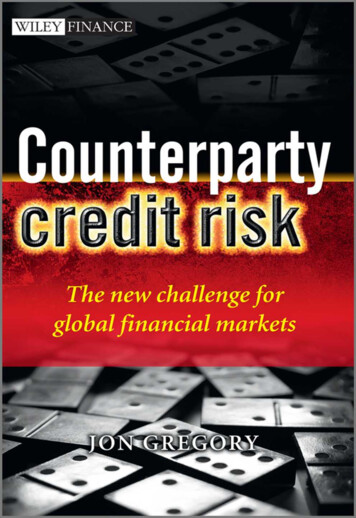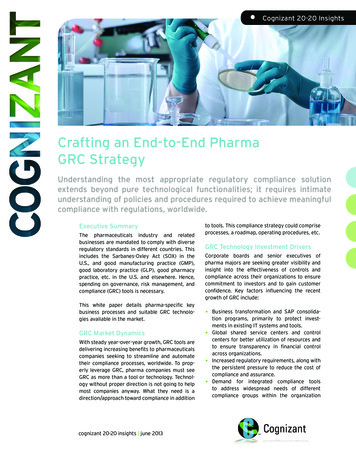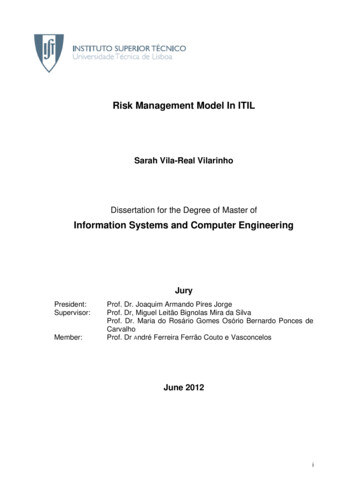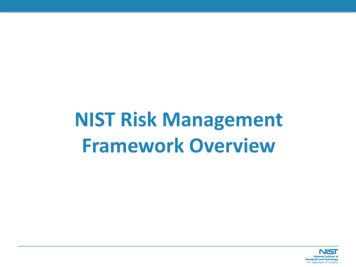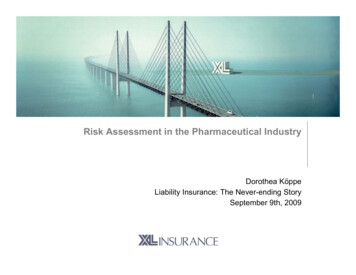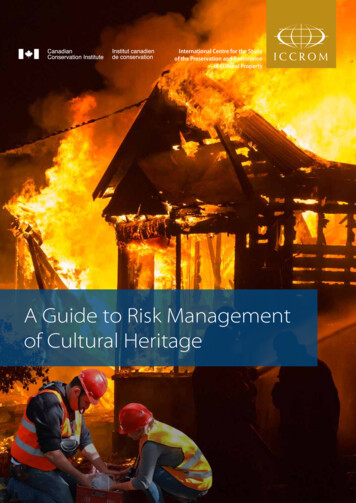
Transcription
International Centre for the Studyof the Preservation and Restorationof Cultural PropertyA Guide to Risk Managementof Cultural Heritage
CO-CREATIONConcept and textJosé Luiz Pedersoli Jr.,Scientia Pro CulturaCatherine Antomarchi, ICCROM- International Centre for theStudy of the Preservation andRestoration of Cultural PropertyStefan Michalski, CanadianConservation InstituteReview, copy-editingand productionInformation designand visualisationCover designResearchZaki Aslan & Anwar Sabik,ICCROM-ATHAR RegionalConservation Centre, Sharjah, UAEChristopher Malapitan &María Foulquié, VisualityMohammed Irqsosy,Maxreative, UAEJosé Luiz Pedersoli Jr.,Scientia Pro CulturaStefan Michalski, CanadianConservation InstituteCopyright ICCROM, 2016 Government of Canada, CanadianConservation Institute, 2016
AcknowledgmentThis guide is an abridged version of the 2016 handbook The ABC method- A risk management approach to the preservation of cultural heritage,a joint publication of the Canadian Conservation Institute (CCI) andICCROM, written by Stefan Michalski (CCI) and José Luiz Pedersoli Jr (forICCROM). The ABC method evolved during ten years of teaching a threeweek ICCROM course on Reducing Risks to Collections to experiencedprofessionals throughout the world, in partnership with the CulturalHeritage Agency of the Netherlands (RCE) and the Central Institute forConservation in Serbia (CIK). The purpose of this booklet is to introducethis most recent thinking on how to achieve effective preservation toanyone responsible for its planning and implementation.The authors wish to acknowledge the contribution of all colleagues andorganizations who participated in the development of the ABC method, aswell as all contributors who kindly provided photographs to support thispublication.Acknowledgment - 3
ForewordCultural heritage tells the stories of the world’s many peoples. Thematerial part of that heritage, objects and sites, tells us of their activities,their perceptions, their skills, and their ideas. It is unique, irreplaceableand unfortunately, vulnerable. Our heritage institutions bear the solemnresponsibilities not only of prolonging their survival but also of makingthem accessible, so that we can know our past. In practical terms, we mustplan how best to reduce the risks to the heritage in our care, and then acton those plans.What are the possible imminent risks to a cultural property? What are therisks of highest probability? Which of those are expected to cause greaterand wide-ranging damages? Do damages differ from a cultural propertyto another? Do these damages suddenly occur or are they accumulativeover time? How can these damages be well understood and assessed forsound decision making relevant to mitigation and prevention? What are thepriorities, given available human capital and budgets? Which institutionsand entities are responsible for cultural sites and museums with whom cancollaboration be sought for risk prevention and treatment?Answering these questions generates an intertwining and complex webof information, which, in turn, requires adequate management throughspecific expertise and methodologies that optimise available resourceswithin time and capacity limitations.This guide, supported with examples and illustrations, provides a scientificmodel and methodology for risk examination and assessment. It enablescultural heritage professionals and institutions to devise intervention plansbased on thorough assessment, which can ultimately facilitate decisionmaking processes. The methodology adopted throughout this guidewas developed in compatibility with the specific requirements of culturalheritage management, and derived from risk assessment methodologiesimplemented in other fields, such as public health and insurance.ICCROM and its ATHAR Regional Conservation Centre in Sharjah(ICCROM-ATHAR) regularly disseminate knowledge and skills relevant
to risk management by implementing training courses and publishing keysources and material in order to benefit the organisations’ member states.The following guide presents a methodology that ICCROM developedin partnership with CCI and other leading heritage organizations bysynthesising the outcomes of several international and regional coursesimplemented in the past decade.Given the current social, economic and political crises prevalent in the Arabregion, as well as the cultural crisis underlying many of these turbulences,the urgent need to study and explore imminent risks to cultural heritage hasbecome more critical. Hence, risk anticipation and assessment, in additionto sound decision making to best utilise available resources, are consideredessential factors for obtaining desired outcomes.This guide places at the hands of professionals in charge of cultural sites andmuseums a methodology for studying risks in a simplified manner that doesnot require elaborate expertise for implementation. Readers will benefitfrom the application of information and expertise explored by the sourcesthis publication provides. Likewise, this guide represents a key resource fordecision makers who may not have sufficient knowledge and skills requiredfor the intricate process of risk assessment and evaluation.We hope that this guide equips professionals working in the related fieldsof cultural heritage, particularly in museums, with a useful foundationaltool that will assist them in performing their duties and achieving theirobjectives.Dr. Zaki AslanRegional Representative of ICCROM for the Arab States.Director of ICCROM-ATHAR Regional Conservation Centre in the U.A.E.Foreword - 5
ContentsWelcome to risk management 8Doing risk management 16ContextUnderstanding the context 20IdentifyWhat are the risks? The 10 ‘Agents’ of deterioration and loss The 6 ‘Layers’ of enclosure The 3 ‘Types’ of risk occurrence Communicating risks 2626495356AnalyzeAnalyzing risks The ABC scales for risk analysis Sources of information Examples of risk analysis How sure are we? 6263777886EvaluateMagnitude of risk and level of priority Comparing risks 9294
TreatTreating risks The 6 ‘Layers’ of enclosure The 5 ‘Stages’ of control Combining ‘Layers’ and ‘Stages’ Selecting the best options Planning and implementing selected options 100100101104111113MonitorMonitor and review; next cycles 116Final considerations 117Contents - 7
Welcome to riskmanagementWHY RISK MANAGEMENT FOR CULTURALHERITAGE?Heritage managers and caretakers often have to prioritize and makechoices about how best to use the available resources to protect collections,buildings, monuments and sites. This means, for instance, having to decideamong options such as increasing security against theft and vandalism,improving building maintenance to reduce water leaks, installing airconditioning in collection storage areas, hiring specialized pest managementservices, installing fire alarm and fire suppression systems, implementingdisaster preparedness and response plans, building new storage facilities,buying ‘conservation quality’ packaging materials, intensifying conservationand restoration treatments, etc.What to do first? What are the priorities of the heritage asset in its specificcontext? How to optimize the use of available resources to maximize thebenefits of the cultural heritage over time?Risk management can help us answerthese questions and make betterdecisions about the preservation anduse of cultural heritage. It allows us toconsider all risks relative to each other inorder to establish priorities and plan ourresources better. We can also apply riskmanagement to deal with any situationthat requires a comparison betweentwo or more specific risks, that involvesa dilemma between preservation andaccess, or between preservation andenvironmental sustainability, etc.?
Can you think of a situation where you hadto compare risks to make a decision?Another important benefit of risk management for cultural heritage is thatit encourages collaboration between different disciplines and sectors. Italso supports the effective communication of risks and risk-related issuesto decision makers, with transparent priorities.WHAT IS RISK?Risk can be defined as ‘the chance of something happening that will have anegative impact on our objectives’.Every time we think about risk we have to consider both its chance ofhappening and its expected impact. If we think only about one or the other wewill have an incorrect understanding of the risk. It is their combination thatmatters. For instance, the impact of an airplane crash is often catastrophic,but the chance of it happening while we are flying is very tiny. The risk ofdying in a plane crash is therefore small, and most of us accept it withoutthinking twice as we travel around in airplanes. On the other hand, the riskof developing some type of cardiovascular disease if we have a sedentarylifestyle and eat poorly is much bigger. It has a higher chance of happening,and has a serious negative impact. That is why many of us do not accept thisrisk, and instead take action to eat a healthier diet, to avoid smoking, and toexercise on a regular basis.It is also important to remember that risk refers to the future, i.e. tosomething that may happen in the future causing a negative impact on ourobjectives.Risks (big and small) are present in our everyday life, and many of our dailydecisions have to do with accepting, rejecting or modifying them.How many risks have you already dealt with today?Welcome to risk management - 9
RISKS TO CULTURAL HERITAGEThe same concept of risk applies to cultural heritage. Many things canhappen that will have a negative impact on heritage collections, buildings,monuments, sites, and on our objectives concerning their use andpreservation. The impact of risks in this case is expressed in terms of theexpected loss of value to the heritage asset.Types of risks to our cultural heritage vary from sudden and catastrophicevents (such as major earthquakes, floods, fires, and armed conflict) togradual and cumulative processes (such as chemical, physical, or biologicaldegradation). The result is loss of value to the heritage asset. For example,if a historic house catches fire there is usually a large or total loss of value tothe building and its contents. When fragile objects of a museum collectionare broken during an earthquake there is a loss of value in that collection.The fading of colors in traditional textiles exposed to daylight also causesloss of value. Sometimes the risk does not involve any type of materialdamage to the heritage asset, but rather the loss of information about it,or the inability to access heritage items. Hence, for instance, a museumcollection or an archaeological site will lose value if they are not properlydocumented or if the existing documentation about them goes missing.Heritage managers and caretakers need to understand these risks wellso as to make good decisions about protection of the heritage (for futuregenerations) while also providing access for the current generation.The images on the next pages are examples of things that have alreadyhappened, but they illustrate what might happen in the future to ourheritage assets. They help us imagine the kinds of risks cultural heritage isexposed to.Can you think of other risks to cultural heritage?
Examples of different types of events and processes that cause damage and loss of value toheritage assets.Top: Destruction of heritage buildings caused by armed conflict (Syria, 2013. Image courtesy ofKamal Bittar).Bottom: Historic house building and contents damaged by strong winds and heavy rain during atyphoon (Philippines, 2013. Image courtesy of Aparna Tandon, ICCROM).Welcome to risk management - 11
19702000Examples of different types of events and processes that cause damage and loss of value to heritageassets. Discoloration and weakening of the feathers of a ceremonial fan caused by light and ultravioletradiation over a period of 30 years (Cairo Museum, Egypt, between 1970 and 2000. Image courtesyof ICCROM Archives).
19392004Examples of different types of events and processes that cause damage and loss of value to heritageassets. Weathering and erosion of earthen architecture structures at a heritage site over a periodof 65 years (Royal Palace of Mari, Syria, between 1939 and 2004. Image courtesy of the SyrianDirectorate-General for Antiquities and Museums).Welcome to risk management - 13
WHAT IS RISK MANAGEMENT?Risk management is everything we do to understand and deal with possiblenegative impacts on our objectives. It includes the identification, analysis,and prioritization (we call it evaluation) of risks. Then we take action to‘treat’ risks, i.e. to avoid, eliminate or reduce the risks that we considerunacceptable. We can also transfer those risks to others. For instance,when we insure our collections we transfer the risk of theft or damage tothe insurance company (for a fee).If one or more risks are evaluated as acceptable we don t need to do anythingabout them. For example, when there is no copyright or security issue,more and more heritage institutions allow their visitors to take picturesusing flash because they know that in most cases, the risk of damage bylight from flash photography is tiny or very small. In other words, we canconsciously accept those risks.It is important to remember that risk management is a continuous process.We have to keep monitoring the risks and adjusting our actions to ensurethat negative impacts on our objectives will be minimized.Used in fields such as public health, the environment, and technology, riskmanagement is an essential tool for government and industry to reach theirobjectives in a more controlled and successful way.Have you ever used risk management in your workbefore?
Because of its importance as a management tool, international standardshave been developed. One of them is ISO 31000:2009, Risk Management Principles and guidelines. The figure below shows the main steps defined bythe standard (inner ring) as well as concepts and tools developed for theheritage sector. In the next chapters we explain these steps, concepts, andtools in more detail.CONTEXTMONITORco mm u n i c atecons10 AGENTSOF DETERIORATIONuu n i c a teRISK MANAGEMENT6 LAYERS OFENCLOSUREsuco6 LAYERS OFENCLOSUREIDENTIFYconmmTREATm u n i c ateco nco msultlt5 STAGES OFCONTROLltcommu n i c a teco nsultEVALUATE3 TYPESOF RISKANALYZELEVEL OFPRIORITYABCSCALESMAGNITUDEOF RISK3 SOURCESOFINFORMATIONWelcome to risk management - 15
Doing riskmanagementCONTEXTMONITORco mm u n i c atecons10 AGENTSOF DETERIORATIONuu n i c a teRISK MANAGEMENT6 LAYERS OFENCLOSUREsuco6 LAYERS OFENCLOSUREIDENTIFYconmmTREATm u n i c ateco nco msultlt5 STAGES OFCONTROLltcommu n i c a teco nsultEVALUATE3 TYPESOF RISKANALYZELEVEL OFPRIORITYABCSCALESMAGNITUDEOF RISK3 SOURCESOFINFORMATION
you are g risk management - 17
Context1 UNDERSTANDING THE CONTEXTMONITORCONTEXTunicRISK MANAGEMENTco mmunicateco m mconsultcomunicateco n sultEVALUATEmTREATulteatnscoANALYZEIDENTIFY
ontext - 19
1 UNDERSTANDING THE CONTEXTIn this step we try to understand all relevant aspects of the context in whichthe heritage asset is situated. This includes its physical, administrative, legal,political, socio-cultural, and economic IRONMENTACTORS RATIVEAND OPERATIONALASPECTSLEGALASPECTSFINANCIALCONTEXTIt is also important to identify all the actors, inside and outside theorganization, that can help us in the process (from the cleaning and securitystaff to the Director and the heritage authority, the fire brigade, the police,the civil defense, the local community, universities, potential donors, etc.).Obviously, we must clearly define our objectives, as well as the scope of ouractions. It must be clear to everyone what the ‘heritage asset’ is. For instance,the ‘heritage asset’ could be all archaeological sites in the country, or oneparticular archaeological site, or only a specific part of an archaeological
site. It could be all historic house museums in the city, one particular historichouse museum, or only a specific part of the collection of one museum.What about your heritage asset? What is it?All this information about the context is necessary to be as effective aspossible when doing risk management.As an example, one might be interested in managing risks to a heritage site thatcontains the remains of an ancient village plus a museum. The site is located ina moderately seismic rural area, nearby a river. There is a native communitynearby that uses part of the site as a sacred place. There is a growingdemand for access to the site by national and international tourism. It has nomanagement plan, and there are no specific laws that regulate the protectionand economic exploitation of this kind of heritage in the country. The museumhas the mission to collect, conserve, and display the archaeological findingsfrom the site. It operates under the responsibility and budget of the NationalBoard of Museums. The site is under the administration of the Departmentof Archaeology. The staff is very small and cannot satisfactorily meet all themaintenance, security, conservation, and documentation needs of the siteand the museum collection. Students from the local school work as volunteerguides. The two park rangers that are stationed nearby help patrol the areawhenever they can. The country is going through a difficult economic period,which means shrinking resources for the heritage sector, but some outsidesponsors have indicated their interest in making contributions.Can you recognize the different aspects of thecontext in the example above that are relevant forrisk management?Context - 21
Try it yourself:UNDERSTAND YOUR CONTEXTConsider your heritage asset. For each aspect of the contextshown on page 20, find at least one specific element that isimportant to understand in order to successfully manage risksto that asset. You can use this form to document your findings.Discuss your results with ALENVIRONMENTTRYIT!
EXTADMINISTRATIVEAND OPERATIONALASPECTSACTORS ANDSTAKEHOLDERSContext - 23
Identify1 WHAT ARE THE RISKS?2 THE 10 ‘AGENTS’ OF DETERIORATION AND LOSS3 THE 6 ‘LAYERS’ OF ENCLOSURE4 THE 3 ‘TYPES’ OF RISK OCCURRENCE5 COMMUNICATING RISKSMONITORCONTEXTunicRISK MANAGEMENTco mmunicateco m mconsultcomunicateco n sultEVALUATEmTREATulteatnscoANALYZEIDENTIFY
CONTEXT10 AGENTSOF DETERIORATIONIDENTIFYANALYZEIDENTIFY6 LAYERS OFENCLOSUREEVALUATETREAT3 TYPESOF RISKMONITORIdentify - 25
1 WHAT ARE THE RISKS?In this step we try to identify all the risks that threaten our heritagecollection, building, monument or site. It is important that we do not missany significant risk. If we are not aware of the different risks that affect ourheritage, our decisions and use of resources will be based on an incompletepicture and will therefore be less effective.When we identify risks, the main question to ask ourselves is this: What cango wrong and cause damage and loss of value to the heritage asset? With ourknowledge and experience we can discover many risks.Give yourself 5 minutes and try to find as many thingsas possible that could go wrong, causing damage andloss of value to your heritage asset. Can you findthree? Five? Ten? More?Sometimes, however, this is not enough to identify all risks. Tools have beendeveloped to help us identify risks in a systematic and complete way. Theyhelp us think about different possible causes, different levels of observation,and different types of risk occurrence. These tools are described below andon the next pages.2 THE 10 ‘AGENTS’ OF DETERIORATION AND LOSSImagine that you are a heritage object, building, monument or site. Now tryto imagine what can cause damage and loss of value to you in the future,in the specific location and context where you exist. In order to help, thediagram on the next page shows 10 agents that can cause deterioration andloss to heritage items. Start with physical forces: what kinds of physical forces can affect mehere? What could cause them? (E.g. strong winds, earthquakes, inadequate handling, overcrowding, accidental collisions, visitor traffic, etc.). Now move to criminals: what kinds of criminal acts could affect me here?
(E.g. opportunistic theft, armed robbery, vandalism, terrorist attack, etc.) Now to fire: what are the possible causes of fire that could affect me? Water: what kinds of water damage can I suffer, and where would the water come from? (E.g. tsunami, river flood, rainwater penetration into thebuilding, water pipe leaks, raising damp from ground water, inadequatecleaning procedures, etc.)And so on for all the other agents. The tables on the next pages containadditional information about common sources of the agents and typicaleffects they cause on susceptible heritage TRHFIREINCORRECTTEMPERATUREWATERLIGHTAND UVPESTSPOLLUTANTSIdentify - 27
Agent of deterioration:PHYSICAL FORCESCommon sourcesTypical effects on heritageIncorrect handling, storage,transportation; collisions, winderosion, excavations, constructionworks, armed conflict, earthquakes,traffic, overload, etc.Collapse, deformation, breakage,abrasion, wear, tearing, etc.ExamplesCollapse of shelves, breakage, deformation and abrasion ofceramic and other fragile objects in the storage room of a museumcaused by earthquake (Image courtesy of ICCROM Archives).
Wind erosion of a stone column in a heritage site(Image courtesy of Anwar Sabik, ICCROM).Painting torn by accident while being handled(Image courtesy of José Luiz Pedersoli Jr.).Identify - 29
Agent of deterioration:CRIMINALS(thieves and vandals)Common sourcesPolitical, ideological, economicmotivation, etc.Typical effects on heritageDisappearance, destruction,disfiguration, etc.ExamplesTheft of part of a sculpture (head) in a heritagesite (Image courtesy of Stefan Michalski).
Extensive damage to a museum collection caused by a bombblast (Image courtesy of AbdelHamid Salah, EHRF - Egypt).Graffiti vandalism on the wall of a heritage structure(Image courtesy of Anwar Sabik, ICCROM).Identify - 31
Agent of deterioration:FIRECommon sourcesTypical effects on heritageLightning, forest fires, gas leaks,fireworks, faulty electricalinstallations or equipment, smoking,candles, arson, constructionand renovation works, etc.Total or partial burning, collapseor deformation by heating,soot deposition, etc.ExamplesHeritage building damaged by fire (Image courtesy of Firas Otman).
Books from a library collection damaged byfire (istock.com/Robert Koopmans).Unsafe burning of incense intemples can cause fire (istock.com/Andrea Zanchi).Identify - 33
Agent of deterioration:WATERCommon sourcesTypical effects on heritageTsunami, flooded rivers, rain,ground water, water pipes, cleaningprocedures, firefighting, etc.Staining, weakening, deformation,dissolution, corrosion,weathering, salt efflorescence,biological growth, etc.ExamplesStaining and soluble-salt damage in museum objectscaused by the flooding of storage rooms located in thebasement (Image courtesy of Hisham Sayegh).
Staining and stronger iron-gall ink corrosion of an archival documentaffected by a water leakage (Image courtesy of José Luiz Pedersoli Jr.).Wetting and damage to archaeological findings exposed to extreme rainduring excavation in a heritage site (Image courtesy of Firas Otman).Identify - 35
Agent of deterioration:PESTSCommon sourcesTypical effects on heritageLocal fauna (insects, rodents, birds,bats, etc.). Sources of food andnesting materials attract pests.Staining, perforation,weakening, loss of parts, etc.ExamplesSignificant loss of parts in a book chewed up by mice(Image courtesy of José Luiz Pedersoli Jr.).
Heritage building has its wooden structure weakened bytermites (Image courtesy of José Luiz Pedersoli Jr.).Weakening, perforations and losses in a wooden sculpturecaused by termites (Image courtesy of ICCROM Archives).Identify - 37
Agent of deterioration:POLLUTANTSCommon sourcesTypical effects on heritageIndustries, vehicles, constructionand renovation works, storage anddisplay materials that emit gases,visitors, restoration materials thatcontaminate the object, etc.Discoloration, weakening, staining,darkening, erosion, corrosion, etc.ExamplesDarkening and staining of the stone façade of a heritage buildingcaused by air pollution (Image courtesy of Stefan Michalski).
Efflorescence of salts (powdery white coating) in a sea shell from anatural history collection caused by chemical reaction with aceticacid, a gaseous pollutant (Image courtesy of ICCROM Archives).Artwork on paper contaminated with residue of adhesivetape (Image courtesy of ICCROM Archives).Identify - 39
Agent of deterioration:LIGHT AND UVCommon sourcesTypical effects on heritageSun, electrical light sources (lamps).Color fading (primary effect oflight); yellowing, weakening anddisintegration (primary effects of UV).ExamplesDaylight entering thismuseum display roomthrough the windowswill cause gradual colorfading and weakeningof susceptible materials(Image courtesy of ofStefan Michalski).
Color fading of a militaryuniform and its medal ribbonscaused by exposure to light(the areas not exposed tolight show much strongercolors) (Image courtesyof ICCROM Archives).Weakening and breakage of the textile fibers in thishistoric house’s curtain caused by exposure to UV fromdaylight (Image courtesy of Stefan Michalski).Identify - 41
Agent of deterioration:INCORRECT TEMPERATURE(too high, too low, fluctuations)Common sourcesLocal climate, sunlight,incandescent lamps, heaters, etc.Typical effects on heritageFaster deterioration by chemicalreactions, deformation, dehydration,embrittlement, softening, etc.ExamplesEmbrittled low-qualitypaper, a chemicallyunstable materialthat deterioratesnotably faster at warmtemperatures (Imagecourtesy of JoséLuiz Pedersoli Jr.).
Degraded cellulose nitratenegative, a chemicallyunstable material thatdeteriorates notably faster atwarm temperatures (Imagecourtesy of Funarte - Brazil).Softening and deformation of a(paraffin wax) candle exposed to highertemperature from direct sunlight whilestored leaning against the wall (Imagecourtesy of José Luiz Pedersoli Jr.).Identify - 43
Agent of deterioration:INCORRECT RH(too high, too low, fluctuations)Common sourcesLocal climate, ground water,inadequate air conditioning,micro-climates, etcTypical effects on heritageDeformation, cracking, flaking,delamination, weakening, corrosion,mold growth, staining, etc.ExamplesCannon balls made of iron suffering from corrosion because of highrelative humidity (Image courtesy of José Luiz Pedersoli Jr.).
Loss of paint in a polychrome wooden sculpture caused by largefluctuations in relative humidity (Image courtesy of ICCROM Archives).Mould growth on a bookexposed to conditions of highrelative humidity (istock.com/Charles Taylor).Identify - 45
Agent of deterioration:DISSOCIATIONCommon sourcesLack of inventory, poordocumentation or identification,misplacing objects, hardwareand software obsolescence,staff retirement, etc.?Typical effects on heritageLoss of information about heritageassets, (temporary) loss or inabilityto access heritage items, etc.ExamplesDetachment and loss of labels will make it impossible to identifyand find the right information about the specimens in thisnatural history collection (istock.com/Jesse Karjalainen).
Inappropriate storage procedures can cause (temporary) loss of booksin this library collection (Image courtesy of José Luiz Pedersoli Jr.).Loss of data and information about the heritage asset caused byfailure of their digital storage system (istock.com/DSGpro).Identify - 47
By systematically considering all 10 agents we can be more confident thatwe have not missed any relevant risk. Remember that there might be severalrisks for the same agent (e.g. water damage by flooding; water damage bypipe leaks; water damage by rainwater infiltration into the building, etc.).It is also important to remember that damage and loss of value will onlyoccur when the heritage item is both susceptible and exposed to the agent,as illustrated in the diagram below. In this diagram, the entire heritage assetis represented by the grey rectangle. Suppose that part of it, indicated bythe blue rectangle, is susceptible to a certain agent of deterioration. On theother hand, the part of the heritage asset that is exposed to that agent isindicated by the red rectangle. This means that only the items that are bothsusceptible and exposed to the agent will be affected, i.e. will suffer damageand loss of value. For example, wooden objects and buildings are susceptibleto termites. They will be affected if exposed to this agent. A metal sculpturedisplayed outdoors is exposed to direct sunlight. This sculpture will not beaffected by light and UV because it is not susceptible to this agent.Can you name one agent of deterioration and identifya part of your heritage asset that is both susceptibleand exposed to this agent?SUSCEPTIBLEAFFECTEDEXPOSED
3 THE 6 ‘LAYERS’ OF ENCLOSUREImagine again that you are a heritage item, and think about the differentlayers that exist around you as shown in the diagram below. If you are anobject from a museum collection, think about: the packaging in which youare stored, or the support on which you are displayed; your storage cabinetor display case (fittings); the storage or exhibition space (room); the buildingwhere the collection is kept (building); the surroundings of this building (site),and the geographic area where the museum is located (r
disaster preparedness and response plans, building new storage facilities, buying ‘conservation quality’ packaging materials, intensifying conservation and restoration treatments, etc. What to do first? What are the priorities of the heritage asset in its specific context? How t






